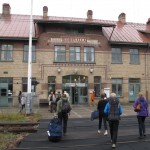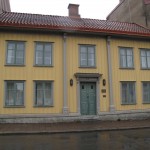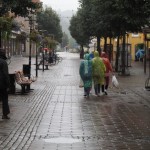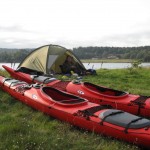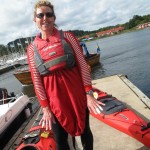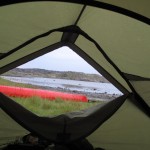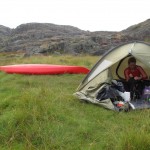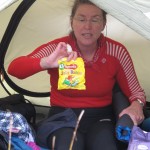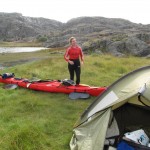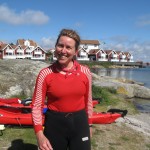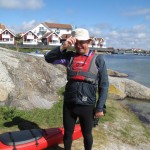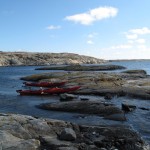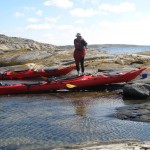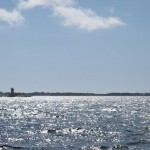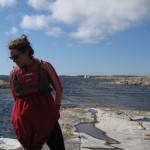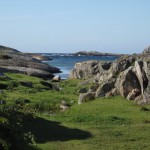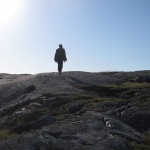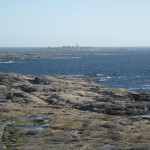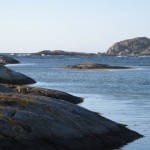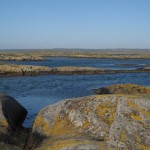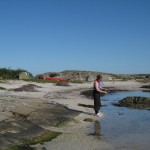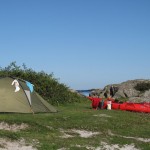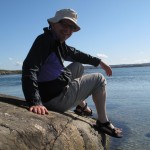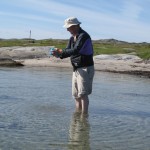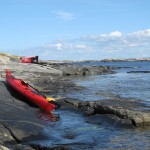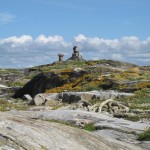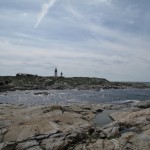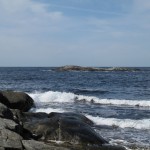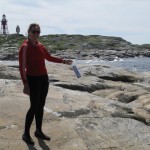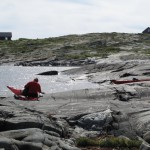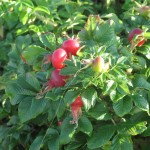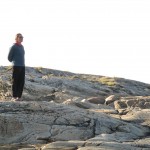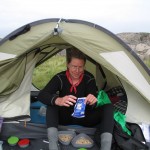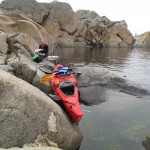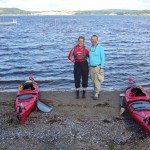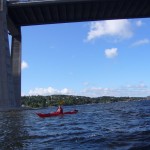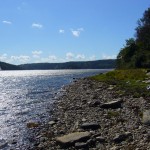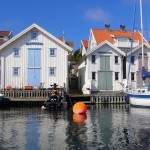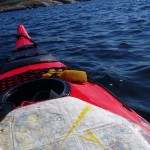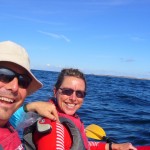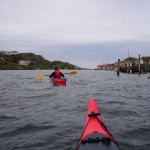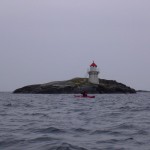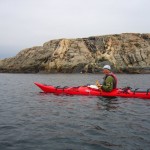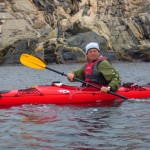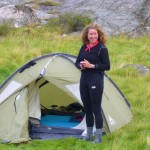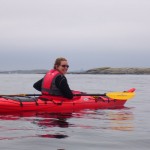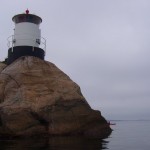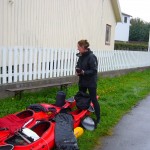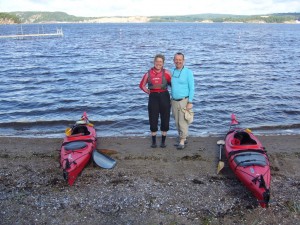 It still seems slightly preposterous that they will rent you a kayak and camping equipment, sight unseen, and set you off on your own into the North Sea with a vague arrangement to meet you somewhere down the coast in 6 days time. The arrangements en route were also, at first sight, a little ‘loose’ – there are plenty of deserted beaches and even whole uninhabited islands, and Sweden has jealously preserved its tradition of Allmannsratt. Anyone can wander the land and camp wild for a night or two so long as you don’t cause any damage, and don’t actually pitch your tent in someone’s front garden. They did give us a map, with some possibilities marked with green dots, backed up with some verbal suggestions.
It still seems slightly preposterous that they will rent you a kayak and camping equipment, sight unseen, and set you off on your own into the North Sea with a vague arrangement to meet you somewhere down the coast in 6 days time. The arrangements en route were also, at first sight, a little ‘loose’ – there are plenty of deserted beaches and even whole uninhabited islands, and Sweden has jealously preserved its tradition of Allmannsratt. Anyone can wander the land and camp wild for a night or two so long as you don’t cause any damage, and don’t actually pitch your tent in someone’s front garden. They did give us a map, with some possibilities marked with green dots, backed up with some verbal suggestions.
It even says ‘no experience necessary’ although I’m pretty sure this sort of thing is going to appeal to a self-selecting audience. The trip was from Uddevalla, Sweden to Rönnäng, a fair few miles down the coast. The area is the Bohuslän archipelago, just up the road from Göteborg – how many lovely Swedes did we meet who had to work that word into the conversation in their perfect English. My favourite was a guy in a sports shop “and so, what is the archipelago like where you come from?”
We’ve been to Sweden a couple of times before – in fact my other half spent a blissful summer in Värmland as a teenager. I don’t know why we don’t visit more often now that it costs less to fly over from Manchester than it does to get the train to London. In fact the return fare was less than the valet parking in the airport, which amused me.
We had been reassured that getting from Landvetter airport into Göteborg and then on to Uddevalla was easy enough. As soon as we got through passport control and out into the rain to wait for the bus, I was quite forcibly reminded of how civilised Sweden always seems. I’m sure it’s got its underbelly – I’ve watched Wallander after all – but even the curly tailed dogs trotting on leads seemed perfectly likely to give you directions to the nearest re-cycling facility, and repeat them in German too if that might help.
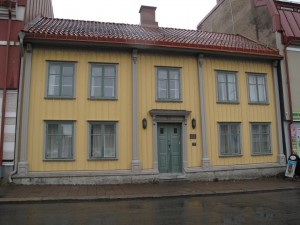 Our first night was in a hotel. We’d dithered and our choice was made for us as by the time we made our mind up all the others were full, but the Carlia was fine. True, it was hideous on the outside, some 1980’s glass and concrete makeover hiding an old building, but inside was just on the functional side of four star. You’ve got to love a language where the formal greeting on the front desk, indeed for any meeting, business or otherwise, is ‘hej hej’ (pronounced hey-hey).
Our first night was in a hotel. We’d dithered and our choice was made for us as by the time we made our mind up all the others were full, but the Carlia was fine. True, it was hideous on the outside, some 1980’s glass and concrete makeover hiding an old building, but inside was just on the functional side of four star. You’ve got to love a language where the formal greeting on the front desk, indeed for any meeting, business or otherwise, is ‘hej hej’ (pronounced hey-hey).
We dined out on the lingua franca of very average pizza, then went for a walk to buy provisions for the trip in, by now, heavy rain. The prospect was looking wet indeed as we loaded our carrier bags in the local branch of Willys and then went back to sort our kit into ‘needed on voyage’ and ‘to be left behind for later’.
The next day the weather surprised us by not raining and we lugged our mountains of luggage by taxi to the kayak centre 2 miles down the road. With more ‘hej hej’s all round we met the guys at the centre and got issued with our kit. For any canoeists, the boats were this year’s model Prijon roto-moulded sea kayaks and the rest of the kit was similarly top end – Trangia stove, Vaude tent, etc. We overcame some slight panic to find that the kit we had brought, and the food we had bought, did actually fit into the storage holes in the front and back of the boats. Incidentally, these proved to be 100% dry all trip. Oh, and they gave us a sea-chart, which seemed distinctly at odds with this ‘suitable for beginners’ business. If truth be told, we’d both paddled before, albeit (too many) years ago, and we’re no strangers to lightweight camping. Heck, I’d even brought my own compass.
The kayaks were on little trollies and we were vaguely pointed down a path to the water’s edge about 500 metres away and left to get on with it. So we wheeled them down the gravel, took the trollies back, spent a few minutes pretending we knew how to adjust the foot rests and then set off up the estuary.
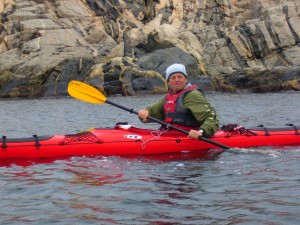 The boats proved to be super stable, and my arms reminded me that the most exercise I get most days is tapping on a keyboard.
The boats proved to be super stable, and my arms reminded me that the most exercise I get most days is tapping on a keyboard.
At first things went well, we were going in a straight(-ish) line, we hadn’t fallen in yet. But as we crossed under a huge road bridge at Sunningen and headed into a couple of kms wide stretch of open water the wind got stronger and stronger. We were attempting to get across to the other side but, despite much paddling effort, I realised we’d been going nowhere for the best part of the last hour. It was by now windy enough that back in my windsurfing days I would have by now run out of small enough sails. We decided to make a dash for a nearby island, and once in the lee, found blessed relief. I honestly considered stopping there for the night. Lesson one – wind does indeed make a huge difference to sea kayaks, that weather forecast printout we’d been given wasn’t just for show. We risked getting out of the boats for a stretch, then pushed on and eventually got across. Even hugging the bank we continued to struggle into a headwind and hours passed. The scenery was beautiful – not exactly wild, more like the English Lake District with salt water. Around 6pm we crossed under another huge road bridge, this time the one connecting the mainland to the large island of Orust. There was a tiny deserted island just past the bridge and we decided that enough was enough for today. In amongst its craggy shores we found a bit of beach with an area of flat grass just behind, and pulled the kayaks right up out of the water. This was the first time we had taken our rented tent out of its bag, and luckily it was almost self erecting, even if the previous users had left us with a minimal 6 pegs. We quickly got some pasta and hot chocolate inside us, and were both in our sleeping bags by 7pm! Because of that, I fully expected to be up and restless by 3am, but in fact it was a full twelve hours later that we emerged. Sea air and exercise eh?
Miracle of miracles, we then noticed an absence of wind noise. Hooray! After admiring a pretty blue starfish, the first proper marine life we’d seen, we eased our aching limbs back into action and packed. Neither of us expected to be able to paddle today but we got back in the boats nonetheless and found to our surprise that we could still move. Our first priority was to get to the small port of Henån – we’d forgotten to buy milk and muesli with water just isn’t the same. It’s a pretty little port but like most others in the area, entirely set up for yachts and a bit difficult to land a kayak. We tottered out of the boats onto a floating landing stage, pulled them out of the water and set off into the town looking rather fetching in neoprene boots and buoyancy aids. I’m sure they’d seen worse. At first everything seemed closed, unless we fancied getting our hair done or buying motor accessories. We then asked in a pizza shop, where we met the only Swedish person in the whole country that didn’t speak English. Just as well I spoke Swedish “err….mjolk?….errr….matbutik?” He pointed us over the bridge to an ultra smart supermarket where I confused myself by making a confident entrance into the recycling centre. You can get a few pennies back for plastic bottles and fizzy drinks cans via a clever reverse-vending machine, which leads to the sight of the local bag-ladies delving in bins to retrieve these. We refilled water from the combined loos and showers on the quayside and headed off. This was still pretty much inland archipelago, especially when we headed up the inside of the island of Flaton, passing queues of cars waiting for the cable ferry back and forth. We’d been a bit worried about progress; last night’s campsite had been the suggested lunch spot. In truth it didn’t matter, we had mobile phones and good coverage from Sweden3G and could easily rearrange our pick up, but still, there might have been a tiny bit of honour involved, so we pushed on a bit. I’m glad we did as it took us from the inland area to the coast proper and a small island joined to Skaftö only by overhead power lines. We scouted around for somewhere to camp, spurred on by the increasing rain. We ended up on a wide inlet, with the beach more mud than sand, and as we got the tent up, the weather started throwing it down. The rain and lack of wind also spurred on the mosquitoes – I’d read that Sweden has 47 varieties of which 45 bite, so we lost no time in getting into the tent. Having said all that, it was perfectly charming to sit there looking out over the completely deserted inlet. It chucked it down all night and I was much in admiration of the tent’s staying power.
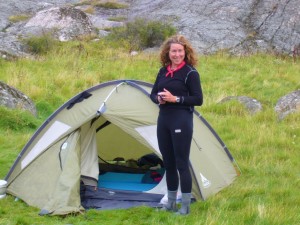 The next morning we had the luxury of milk on our muesli. We also spotted someone rowing a skiff around the inlet but I think ‘our’ bit was too shallow to allow them to visit. The mozzies were still buzzing so we made a bit of a dash to get packed. The good thing was that as soon as you are off the shore, you leave the insect life behind. It was a great morning, fresh without being too windy, and sunny enough to have us slapping on the sun screen. Confidence high from the good progress yesterday, we set off across open water towards the nature reserve island of Härmanö. It was still rough enough to dissuade from going down the side of the island facing the ocean, so we instead paddled into the channel of water in which nestles the village of Gullholmen. It is one of the area’s oldest fishing villages although these days it is thoroughly given over to the yachting set and is pretty beyond compare. I would really like a holiday house there, but it would seem that property prices are almost comparable to my old flat in London. We paddled through, our kayaks enabling us to sneak under bridges where anything bigger would have to use one of the three proper harbour entrances. Feeling the need for civilisation we spotted a bathing beach and pulled the boats up there. It was all very well kept, the houses like most in Sweden in muted tones of russet and mustard, and it was mainly car free with only paths between the houses. While we were trying to get our bearings I spotted a chap taking his rubbish up to the bins where a vehicle could get access to pick it up. I asked if there was a shop, and also if there was anywhere we could refill our water bags. He offered to fetch us water from his adjacent house, saying he’d better leave us outside as his wife had just taken a shower and was “still nude”. He jokingly asked if there was anything else he could so for us. I’m convinced that what often comes off Swedish people as slight sarcasm is really meant as warm humour.
The next morning we had the luxury of milk on our muesli. We also spotted someone rowing a skiff around the inlet but I think ‘our’ bit was too shallow to allow them to visit. The mozzies were still buzzing so we made a bit of a dash to get packed. The good thing was that as soon as you are off the shore, you leave the insect life behind. It was a great morning, fresh without being too windy, and sunny enough to have us slapping on the sun screen. Confidence high from the good progress yesterday, we set off across open water towards the nature reserve island of Härmanö. It was still rough enough to dissuade from going down the side of the island facing the ocean, so we instead paddled into the channel of water in which nestles the village of Gullholmen. It is one of the area’s oldest fishing villages although these days it is thoroughly given over to the yachting set and is pretty beyond compare. I would really like a holiday house there, but it would seem that property prices are almost comparable to my old flat in London. We paddled through, our kayaks enabling us to sneak under bridges where anything bigger would have to use one of the three proper harbour entrances. Feeling the need for civilisation we spotted a bathing beach and pulled the boats up there. It was all very well kept, the houses like most in Sweden in muted tones of russet and mustard, and it was mainly car free with only paths between the houses. While we were trying to get our bearings I spotted a chap taking his rubbish up to the bins where a vehicle could get access to pick it up. I asked if there was a shop, and also if there was anywhere we could refill our water bags. He offered to fetch us water from his adjacent house, saying he’d better leave us outside as his wife had just taken a shower and was “still nude”. He jokingly asked if there was anything else he could so for us. I’m convinced that what often comes off Swedish people as slight sarcasm is really meant as warm humour.
We picnicked on the beach then carried on south. Initially we stuck close to the shore heading for Hällevikstrand. We spotted a romantic looking lighthouse further out on a small rock off shore and pulled up on some tiny skerries for a better look and to take some photos. It was a great spot, and way out past the lighthouse we could see the outer islands south of Härmanö. On an impulse we decided that looked a much better place to be and set off in the general direction. It took us less time than we’d imagined, nipping past some inner islands and eventually we spotted a gap where we could see proper surf between two islands. Heart in mouth I decided I wanted a look at the outside of the island and paddled through the gap into the waves, Flip gamely behind me. As I got out, I could see to my left what looked like a man and a boy standing on a cliff. I have to say my vision was all a bit blurry and salt stung at this point. We decided that discretion was the better part of valour and came back through the gap into the calmer water, only to turn a corner and find a most fabulous beach backed by flat grass. We pulled the boats in. This has to be one the best spots that I’ve visited on this earth. I could see the surf off beyond some rocks and hear the wind overhead and yet here it was warm and sunny, with lichen covered rocks and clean sand. It was completely deserted, out of sight of the mainland. We put the tent up then went exploring on foot, up to the high point where some previous visitors had left a black flag flying and depicted a skull and cross-bones with rocks on a bare stone slab. We could then see that what we had both thought was a human father and child was in fact another island with two lighthouses, one bigger than the other. We found more wild life – a snake, bigger than a metre long, gave us a fright by slithering in Flip’s direction across a rock before nipping off into the grass. The shallow water was full of hermit crabs, as well as the more conventional variety. I was sitting with my sandalled feet resting on the sandy bottom when I felt a nip – a crab had decided it needed to find out what human tasted like and was having a go at my foot!
The following morning we lazed around and eventually tore ourselves away from this paradise at around noon. Confidence grown yet again we paddled straight out through the gap into the North Sea swell and headed down past the village-island of Käringön in the direction of the little and large lighthouses on the island of Måseskär. It turns out that the larger light is the old one, replaced in 1978. It should have been pulled down and scrapped but a preservation society sprang up and persuaded the government to give them not only the lighthouse but the money they had been intending to use on demolition. Although it wasn’t super-windy today, the sea was still showing the effects of yesterday in a heavy swell, and at times, even though only 7 or 8 metres apart, we were losing sight of each other in the peaks and troughs. We found we were able to land on the rocks near the twin lighthouses and went for a walk round. All of a sudden Flip called me over, excitedly holding up a plastic Pepsi bottle. It had a message in it – from a guy in Denmark who had included his email address and wanted to know how far his missive had travelled. The bottle was way above the tide line, so we photographed the paper, replaced it and tossed the bottle back out to sea.
We were quite a way out from the mainland so I got my compass out to set a course from a bearing off the sea chart. Much to my amazement, this worked really well and we found ourselves passing surf kayakers off the rocks of Soskar on our way to our planned camp site at Slubbersholmen, a tiny island guarding the entrance to a natural lagoon on the bigger island of Mollön. This was a real yacht hiding place with several expensive looking boats at anchor. This was more civilised if you could call it that, it had a wooden hut with an earth toilet at one end and several bins at the other for you to place your sorted recycling – very Swedish. As we gazed into the clear shallow water we spotted one, two, then three big crabs that proceeded to engage in 3-way crab wrestling. I think two of them were chasing off an impostor from their pitch. After the incomer had retreated from the field of battle, one of the incumbents kept coming out of the weeds just to make sure, with a definite air of ‘come back if you think you’re tough enough’.
The next day, we got thoroughly wet out at sea exploring another lighthouse, so paddled into Skärhamn. Like drowned rats, we left our boats on a floating pontoon and waddled into the harbour area in soaking waterproofs and neoprene boots. We sheepishly enquired in the tourist information office if we could get a hot drink anywhere and were directed across the square to a very smart craft centre and cafe. The place was crawling with tour buses. Woe betide any kayakist who gets between a well dressed Swedish matron and the cake counter! It had tourist prices to match, but the twenty-odd quid for two sandwiches, two kanelbullar and hot chocolates was well worth it to sit in the warmth. Kanelbullar are cinnamon buns – until now, for me these had been the epitome of coffee time in the US, but for Flip they will always evoke that summer in Värmland when she was 15. We regrouped, put dry clothes on over the wet ones and set off again, to reach our last camp site on yet another deserted island. It was enchanting and we paddled right the way round, but found that the only flat place to camp was a goose stamping ground, covered in their dropping. We played goose-poo croquet with the canoe paddles to clear a spot to camp and had our final night’s camping meal, of noodles and cake. That day I’d been certain that I’d spotted a seal in the wind and rain, and was gutted that Flip hadn’t seen it, so on our last day, as we made our way to Rönnäng, we both kept our eyes peeled and I wished really hard. Success rewards persistence, and as we bobbed around eking our last day out, a head bobbed up and gazed at us. The lovely seal then swam close enough to be seen under Flip’s boat before popping up again while I struggled to get the camera out. We thought it was gone when I thought I heard someone clearing their throat behind us. It was the seal again, blowing it’s nose, as if to make sure we didn’t miss her! We moved on eventually and paddled into Rönnäng via the narrow southern entrance, and found the small cove where we were to be picked up. A quick phone call later and we were reunited with Joakim Hermanson, the guy whose boats we had been sitting in, and whose tent we had been sleeping in for the past six days. As we loaded the boats onto the roof of his Land Rover, I really did feel a sense of loss now that we were returning to the everyday, travelling in a car with the heater on, hoping we didn’t smell too much. We needn’t have worried, he does this for fun himself, as well as it being his business. It was part of the deal that we had to wash the boats back at his centre, Upplevelsebolaget in Uddevalla. He repaid the favour by making us coffee, making time for a chat, before insisting that he would save us the taxi fare and drive us into town for the train.
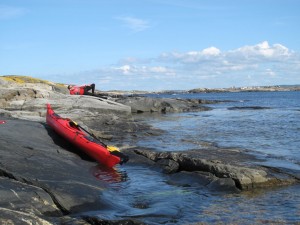 We caught the next train, and an hour later were in the centre of Göteborg; ten minutes after that, checking into the Clarion Collection Hotel Odin hotel on Odinsgatan. I got my first taste of Göteborg chattiness as the young lady desk clerk launched into a conversation about my document bag, then what a coincidence as the very last person before me had the same name as me, etc etc, as though we’d known each other for years.
We caught the next train, and an hour later were in the centre of Göteborg; ten minutes after that, checking into the Clarion Collection Hotel Odin hotel on Odinsgatan. I got my first taste of Göteborg chattiness as the young lady desk clerk launched into a conversation about my document bag, then what a coincidence as the very last person before me had the same name as me, etc etc, as though we’d known each other for years.
The room would be best described as a condo, fairly unusual in Europe where hotel rooms tend to be on the small size. After careful consideration we decided that it was exactly the same size as my flat in London, the only real differences being that the bedroom and lounge were combined, and it was fitted to a much higher standard, complete with wet-room bathroom and triple glazing. The doors to the corridor were made of heavy steel and sealed like a safe. It was a strange treat to now have a comfortable bed at our disposal after a week of bedding down on a sleeping mat on the floor.
We spent five nights in Göteborg. I don’t propose to go into huge detail, just list a few highlights. Of the museums, my favourite was the Röhsska, which is the place for modern design. There was a great exhibition of Japanese art, including some ancient and graphic pornography, there’s no other word for it. We also spent time at the Maritime Museum, where there was a large section on Swedish emigration to the US. I had no idea that so much demand was fuelled by the shipping lines themselves, who drummed up business by spreading fabulous stories of the new life to be had. It had resonance for me as I made a similar journey as a small child as a ‘twenty five quid pom’ to Australia. Apparently many, many Swedes only got as far as Göteborg, as they moved to the city to try and earn the fare, but never made it.
The best part of our stay in the city, and a hidden gem of a bargain, was back out on the islands. Those close to Göteborg are considered part of the city’s tram network, so for the 65 kronor cost of a day’s tram pass you can ride the ferries all day long. We got the tram an hour out to the end of the line at Saltholmen, where the ferry terminal is, and where the lady in the ticket kiosk advised us that Vrångö would give us the longest ferry ride. The islands vary hugely in size – we called at five or six before reaching our destination. I was tickled pink at Köpstadsö where they don’t allow any vehicles at all apart from wheelbarrows, of which there were several dozen left at the tiny ferry terminal. Vrångö is a nature reserve, a couple of km from end to end but only 500 metres wide at the middle. We made use of a footpath right round the wild north tip of the island, before catching another couple of ferries and island hopping back in time to pack for the flight home.
[Mike and Flip arranged their kayaking vacation via a UK company called Nature Travels.]
– Writer, Adventurer Mike Hughes lives in North Wales and is owner and proprietor of Catshoegazing, an excellent blog.

